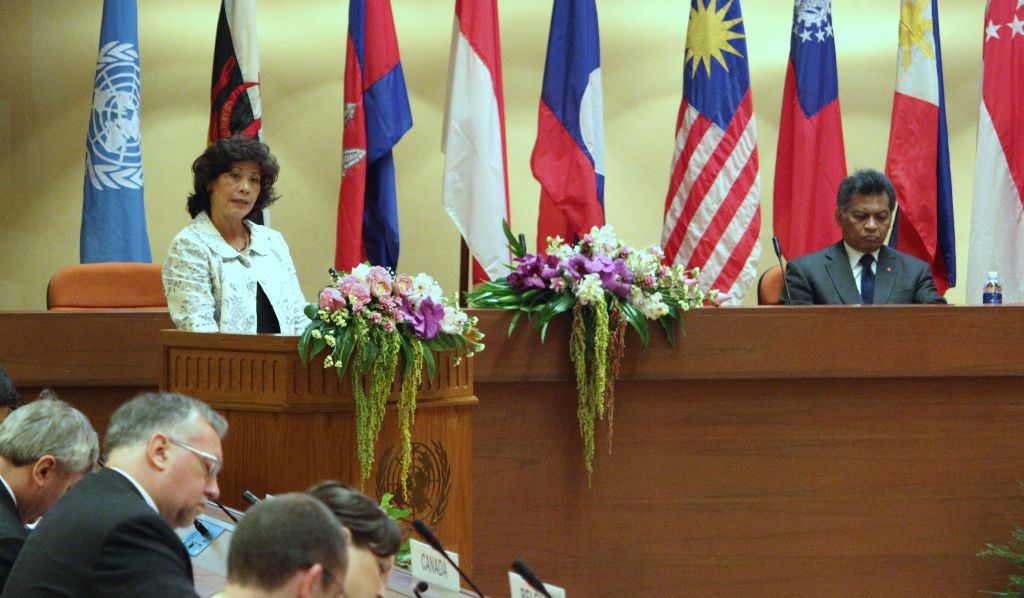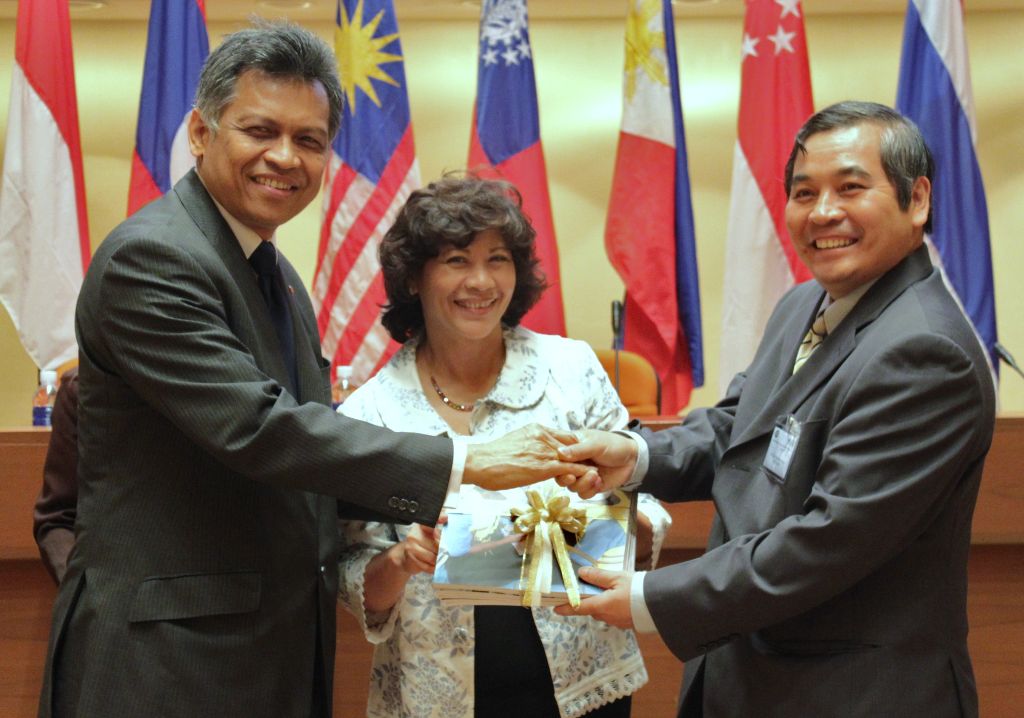Towards ASEAN-UN Partnership in Disasters
Post-Nargis Lessons Learning Conference: Institutionalizing Good Practices, Strengthening Partnership
30 August 2010, Bangkok, Thailand
H.E. Dr. Surin Pitsuwan, Secretary-General of ASEAN, Chairman of the ASEAN Humanitarian Task Force;
Excellencies,
Distinguished Guests,
Ladies and gentlemen,

A warm welcome to you all. We gather here today with a sense of accomplishment at having been able to assist Myanmar in its hour of need two years ago when Cyclone Nargis unleashed its fury on the country. The appalling loss of life, dislocation of millions and wanton destruction it caused remind us that the human tragedy from natural disasters transcends national borders, institutional boundaries and distinctions between communities and people. The sheer scale of the devastation they wreak makes these differences unimportant.
Even as we look back on what we learned from the experience with Cyclone Nargis in Myanmar, similar tragedies are unfolding elsewhere in our region, such as in Pakistan, China and now Indonesia. Once again, the United Nations, its member States, the international donor community and civil society organizations have rushed to assist a government and governments overwhelmed by challenges far outstripping their coping capacities.
In recent years, such disasters have become a recurring phenomenon in Asia and the Pacific which has historically been the region worst affected by disasters globally in terms of casualties. The reason is that the many countries in our region are developing countries characterized by poor infrastructures, population concentrations in vulnerable areas, lack of financial, technical and human resources, and ineffective and inefficient administrative structures. As disasters like Cyclone Nargis strike these countries time and again, we are forced to switch our attention from one tragedy to another, each a unique challenge, each demanding a unique response. Yet, even as we put out this succession of fires, as we must, we need to pause and ask ourselves:
- What are we learning from each experience?
- Are we better prepared to deal with the next such challenge?
- What can help us move more quickly to limit the casualties and the damage?
I am very pleased that ASEAN has helped us to stop and reflect.
There are three key lessons to be learnt from the Post-Nargis experience in Myanmar. First, good governance within the affected country is paramount. No matter how much support is mobilized externally, the effectiveness of the response is ultimately defined by the internal governance of the country. The Myanmar Government initially took things in its own hands and tried to deal with the situation on its own. However, it was not prepared for the scale of the devastation and realized very soon the task was beyond its capacity to address without outside assistance. This is true of most disasters. The isolation of the country over the years meant such assistance depended on trust between the Government and those who were willing to lend it a helping hand. The sudden need to engage with a multiplicity of external actors, relationships with many of whom had been strained, was clearly an impediment to relief efforts. To the credit of the Government, it rose to the occasion swiftly. By endorsing the ASEAN-UN partnership within the Tripartite Core Group (TCG), the Government displayed its readiness to set aside other issues, focusing instead on what mattered most —human lives. We could not have moved forward without this. Over the next two years, the Government worked with ASEAN and the UN to shape the TCG into a viable decision-making body, and I congratulate the TCG.
Second, within the UN system, we learnt the importance of adding value to our efforts to assist Myanmar. At the global level, the UN Secretary-General, Mr. Ban Ki-moon brought the weight of his office to open up a dialogue with the Government to issue visas to personnel of relief agencies and launched, in partnership with ASEAN, the first donor conference in Yangon. At the regional level, ESCAP, as the regional arm of the UN, followed up quickly to bring together the lessons learned from similar disasters elsewhere in the region as inputs into the recovery efforts. The ESCAP-ASEAN High Level Experts Group Meeting on Post-Nargis Recovery and Livelihood Opportunities in Myanmar in October 2008 fed into the PONREPP which was launched here. ESCAP also provided technical support in statistics and supported the periodic reviews. As a member of the ASEAN Humanitarian Task Force for the Victims of Cyclone Nargis (AHTF), I was privileged to accompany the Chair of the Tripartite Core Group and Dr Surin Pitsuwan, the Secretary-General of ASEAN, and at that time Ambassador Chua from Singapore (representing ASEAN) to visit the affected communities. At the national level, the UN Country Team (UNCT) for Myanmar was a part of the TCG. The UNCT operationalized relief efforts on the ground. OCHA, UNICEF, WFP, UNHABITAT, UNDP, FAO and others worked together to coordinate the channeling of support received from various quarters to the communities. The UN system partnered with civil society, with organizations such as the Red Cross, Save the Children and Merlin at the frontline. The operations on the ground could not have been possible without the commitment of these civil society organizations, especially their national staff. This cascading flow from policy to strategy to action within a very short time demonstrated how the seemingly complex machinery of the UN can move with speed and effectiveness when a member state needs urgent assistance.
Third, the international donor community should be able to move faster with its aid and assistance to countries in such situations, and be able to sustain its support beyond immediate relief. The more than $ 103 million of funds pledged here by donors last November for the priority action plan of the PONREPP showed the international community was not lacking in generosity or willingness to support the country. However, differences in perception between donors within the country and those outside led to a slower response than what might have been possible. Swift support in the immediate aftermath of the disaster could have saved more lives and reduced the damage. Furthermore, there is a need for donors to draw a better balance between humanitarian relief and early recovery on the one hand, and long-term recovery, rebuilding and development, on the other. While many donors were able to commit funds for the former, raising funds for the latter has proven a more difficult challenge. Today, Cyclone Nargis is still exacting a heavy cost on Myanmar as affected villagers and farmers still struggle to recover their livestock and livelihoods. We hope that efforts put in place by the TCG would continue.
Excellencies, distinguished guests, ladies and gentlemen,

Let me now move to the questions concerning our preparedness for similar disasters in the future and the mechanisms that we can devise for more rapid and sustained responses. The most striking feature of the Post-Nargis experience has been the partnership between ASEAN and UN. Although the mandate of the TCG officially came to a close at the end of July 2010, ASEAN and UN are of the view that the mechanism has demonstrated how the sub-regional organizations and the UN can partner with civil society to work closely with countries like Myanmar. This mechanism made it possible for us to mobilize and deploy financial, technical, human and institutional resources to respond effectively to the disaster. The best practices from this experience, as documented in the series of books brought out by ASEAN, form a very important step in institutionalizing our partnership to address future disasters in the region. I congratulate the ASEAN secretariat office under the leadership of Dr. Sabandar.
As a further step, the UN is now working closely with the ASEAN Secretariat to develop a Memorandum of Cooperation (MoC) on Disaster Management, covering all stages of the disaster management cycle comprehensively — from preparedness and risk reduction to mitigation, response, recovery, reconstruction and development. The MoC builds on existing agreements and arrangements ASEAN has entered into with specialized UN agencies, as set out in the ESCAP publication of 2008, Striving Together: ASEAN and the UN, which incorporates contributions from members of the UN Asia-Pacific Regional Coordination Mechanism. The MoC is intended as a platform to identify needs and opportunities to close remaining gaps, and to act as the strategic framework guiding future ASEAN-UN cooperation in this area. Subject to approval of the ASEAN Committee on Disaster Management (ACDM), the draft MoC could be submitted, if all agree, to the ASEAN-UN Summit in Vietnam this October. It is my hope that this instrument will help consolidate our respective experiences and institutionalize our strengths for the benefit of our member states.
I thank you for coming together to learn the lessons that we must never forget.